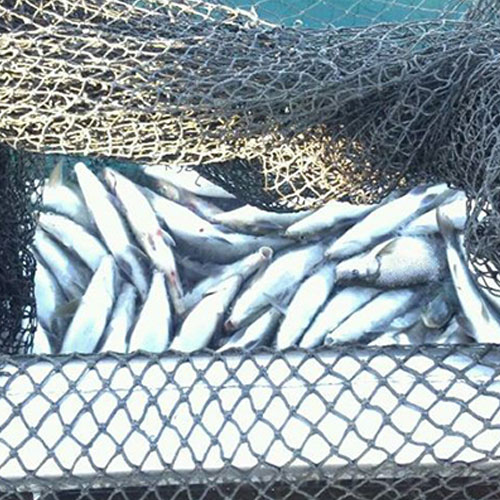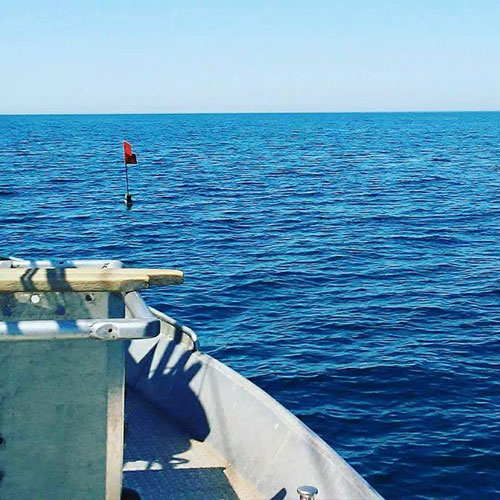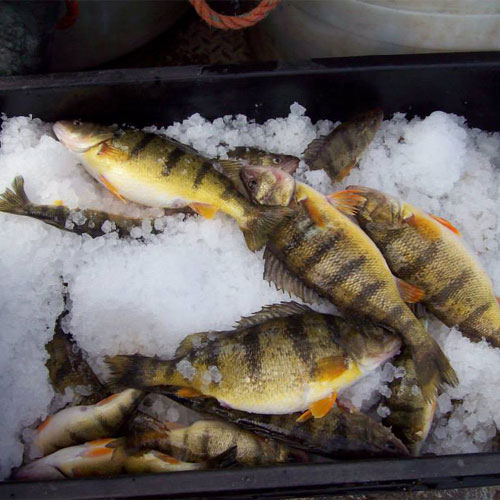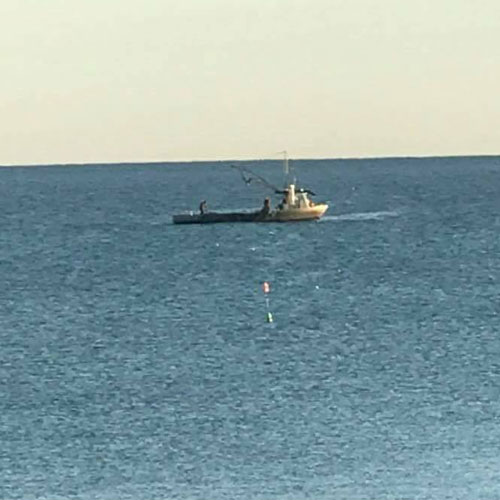
 The lake whitefish (Coregonus clupeaformis) is the most economically valuable freshwater species of the Great Lakes. Its exceptionally fine flavor has been extolled since the days of the early explorers.
The lake whitefish (Coregonus clupeaformis) is the most economically valuable freshwater species of the Great Lakes. Its exceptionally fine flavor has been extolled since the days of the early explorers.
A deep-bodied fish, it is characterized by a small head with a blunt snout overhanging the lower jaw. Older fish often develop a fleshy bump at the shoulders, which makes the small head look even smaller. In general, its coloration is greenish brown over the back, shading to silver on the sides and silvery white below.
Average-sized whitefish in the commercial catch measure 17 to 22 inches in length and weigh 2 to 4 lbs. The largest individual on record was a 41 lb. heavyweight taken from Lake Superior in 1918.
Commercial fishing, for the most part, is carried out by means of trapnets and gillnets set during the open water season. While not noted as a game fish, in recent years the lake whitefish has been the object of an active sport fishery in many parts of its range. Anglers catch it on a small hook usually baited with a fish egg.

WHY WHITEFISH
Amazing but true: the Great Lakes basin holds nearly 20% of the fresh water in the world. And this spectacular ecosystem is home to the lake whitefish, or Coregonus clupeaformis.
Yesterday
Native Americans and early European explorers recognized the value of Great Lakes Whitefish. Following are excerpts from the book “The Indians of the Western Great Lakes 1615-1760” by Vernon Kinietz (University of Michigan Press, 1940).
Explorer Gabriel Sagard in his Le Grand Voyage witnessed ceremonies and practices that Native Americans carry on when they catch the great fish called Assihendo (Great Lakes whitefish), which is a fish as big as the largest cod, but much better.
The fishing of the Ottawa at Mackinac was described by Antoine de la Mothe Cadillac about 1695, who wrote: “Moreover, better fish can not be eaten, and they are bathed and nourished in the purest water, the clearest and the most pellucid you could see anywhere.” He further described lake whitefish: “That is the most delicate fish of the lake. They are as large as shad in France.”
The taking of the Great Lakes whitefish by the Chippewa was described by Claude Dablon: “It is called in the native language Atticameg, and in ours ‘whitefish’, because in truth it is very white; and it is most excellent, so that it furnishes food, almost by itself, to the greater part of all these peoples.”
Claude de La Potherie wrote of Chippewa catching lake whitefish: “Those people are very skilful in a fishery they carry on there, of fish which are white, and as large as salmon.” He further states about lake whitefish: “This kind of fish is large, has firm flesh, and is very nourishing.” The Chippewa caught more whitefish than they could eat and carried the surplus to Mackinac, where they sold it at a high price to both French and Indians.
French explorer Antoine Denis Raudot wrote in 1710: “The fish that they fish for there are the trout, the sturgeon, and the whitefish. This last, which is the size of a shad and has no other bones but one in the middle, must be the best fish in the world, since all those who have eaten it say that they never grow tired of it and prefer it to all other meats that one could find.”

Today
Great Lakes Whitefish offers versatility, value and convenience. It has a sweet, light flavor that many who “don’t like fish” can appreciate. Its mildness makes it perfect for a variety of dishes, while it also adapts to almost any method of cooking. What’s more,
Great Lakes Whitefish is available flash frozen, year round, with bones removed for convenience.
Great Lakes Whitefish brings you a high-quality, low-cost protein option with omega-3, vitamins and minerals.
Other Species
Some fishermen also catch Chubs, Channel Catfish, Yellow Perch, White Perch, White Bass, Sheepshead. Quillback, Carp, suckers, rock bass and crappies. These species can be caught in Michigan waters depending on what type of license the fishermen own and which waters they fish in.
QUALITY
Great Lakes Whitefish comes from the largest freshwater lake system in the world. This results in several important benefits.
Wild vs. Farmed
Most chefs and cooks believe that wild-caught fish offers superior flavor and texture to fish that is farmed. Wild Great Lakes Whitefish is found only in cold northern waters. Reputable brands guarantee that their fish is accurately labeled Wild Caught from the Great Lakes-Product of U.S.A.
Frozen vs. Fresh
Studies show that when fish is carefully vacuum packed and frozen and expertly handled, it keeps the flavor and texture that is “fresh from the water.” Tests with consumer panels at Michigan State University Department of Food Science and Human Nutrition Sensory Evaluation Laboratory concluded that consumers could not differentiate a cooked flavor difference between fresh and vacuum packed frozen lake whitefish. Even when properly refrigerated, fresh fish must be used within 2 to 4 days. The nutritional value of fresh and frozen fish is very similar.
Government Regulation
To ensure only the freshest fish get to your table, Michigan’s commercial fish must meet U.S. Food and Drug Administration regulations, enforced regionally by the Michigan Department of Agriculture. The FDA sets a “trigger” level for any contaminants of concern, such as PCBs and mercury. Fish may not be sold if they exceed the trigger level.
A Matter of Distance
Great Lakes Whitefish from Michigan fisheries is caught and processed right in the Great Lakes area. Our fish makes no journeys to or from Asia! Look for the country of origin label on any fish you purchase. Also check where the fish was processed. You may be surprised.
GREAT LAKES WHITEFISH HEALTH PROFILE
Great Lakes Whitefish boasts a long list of health advantages. Medical professionals are encouraging the nation to eat fish twice a week because it’s rich in protein, vitamins and beneficial fatty acids. Read on about the powerhouse of nutrition offered by Great Lakes Whitefish fillets.
Vitamins
A 3-oz. serving of Great Lakes Whitefish is also a good source of niacin plus Vitamins B6 and B12. It also contains small amounts of thiamine, riboflavin, folate and Vitamins A and E.
Minerals
Three ounces of Great Lakes Whitefish count as an “excellent source” of phosphorus and selenium and a “good source” of potassium. You’ll also find small amounts of calcium, iron and zinc in our fillets.
Omega 3
One 3-oz. serving of whitefish features Omega-3 fatty acids (a very good thing): .35g of EPA and 1.03g of DHA, to be exact. That’s more than pink and sockeye salmon. The government requires us to add: *Supportive but not conclusive research shows that consumption of EPA and DHA omega-3 fatty acids may reduce the risk of coronary heart disease.

What About Contaminants?
Lakes Superior, Michigan and Huron have lower levels of mercury than inland lakes and reservoirs. Lake whitefish as a species are at the bottom of the scale in mercury buildup as well. Lab testing has verified that no upper Great Lakes whitefish exceeds the FDA mercury limit.
Great Lakes Whitefish are rigorously monitored for contaminants and pass FDA standards for consumption.
THE POWER OF GREAT LAKES WHITEFISH
Great Lakes Whitefish is of great economic importance to the region.

Jobs
Dozens of Michigan fishermen and other folks earn much of their livelihood with Great Lakes Whitefish. The jobs benefit individuals, families and their communities, and the surrounding area.
Image
Family Fisheries
Fishing is a way of life for many family fisheries in Michigan. Several generations have fished both for their own needs and to sell commercially. Pride and tradition carry them through the seasons and the years spent on the waters they know and love.
Stewardship
Supporting and continuing an abundant supply of Great Lakes Whitefish is a top priority for fisheries in the area. Working in conjunction with the commercial fishery, state and tribal fishery management authorities manage the Great Lakes whitefish fishery to ensure its sustainability well into the future.
WHAT SCIENCE SAYS…
Diet and Reinfarction Trial (DART)
- Study of 2033 men who had recovered from heart attacks
- The men who ate fish had a 29% reduction in 2 year all-cause mortality compared with those not advised
- Published in Lancet in 1989
Western Electric Study: 30-Year Follow-up
- 1822 men were followed for over 30 years
- Baseline determined fish consumption
- Results showed an inverse association between fish consumption and death from Coronary Heart Disease (CHD)
- Published in New England Journal of Medicine 1995
National Health and Nutrition Examination Survey (NHANES)
- Assessed the level of fish consumption as a risk factor for stroke
- Final conclusion was that women aged 45 to 70 years who consumed fish more than once a week had an age-adjusted risk of stroke incidence about half that of women who never consumed fish
- Published in the Archives of Internal Medicine in 1996

Jobs
Dozens of Michigan fishermen and other folks earn much of their livelihood with Great Lakes Whitefish. The jobs benefit individuals, families and their communities, and the surrounding area.
Image
Family Fisheries
Fishing is a way of life for many family fisheries in Michigan. Several generations have fished both for their own needs and to sell commercially. Pride and tradition carry them through the seasons and the years spent on the waters they know and love.
Stewardship
Supporting and continuing an abundant supply of Great Lakes Whitefish is a top priority for fisheries in the area. Working in conjunction with the commercial fishery, state and tribal fishery management authorities manage the Great Lakes whitefish fishery to ensure its sustainability well into the future.
FUN FACTS
-
Great Lakes Whitefish contains more omega-3 fatty acids than pink and sockeye salmon.
-
It’s been said that “nobody got rich, but they did get by” on the Great Lakes fishing industry.
-
Saute nuts in butter to make a quick and delicious sauce for Great Lakes Whitefish; try almonds, pistachios, pecans, walnuts or pine nuts.
-
The Great Lakes sprawl over 95,000 square miles.
-
Whitefish prefer to spawn on rock, honeycomb limestone, gravel or sand.
-
The Anishinabe (Native American) word for Great Lakes Whitefish is Atikamig.
-
Early Native Americans would make a powder of smoked Great Lakes Whitefish for use in stew, soups and fish pies; they would also mix the powder with fresh blueberries.
-
Fannie Farmer’s 1918 Boston Cooking School cookbook calls whitefish “the finest fish found in the Great Lakes.”
-
The largest lake whitefish on record weighed a whopping 42.67 lbs. (18.9 kg), caught in Lake Superior in 1918.
-
The Great Lakes Whitefish isn’t quite white: the skin is actually greenish-brown on the back, with silver sides and a silvery-white belly.
-
From about 800 A.D. to the 1600s, many Native American families in the Great Lakes region had established fishing villages and gardens of corn, squash and beans.
-
The five Great Lakes hold a combined total of about 5500 million cubic miles of fresh water.
-
The scientific name for lake whitefish is Coregonus clupeaformis.